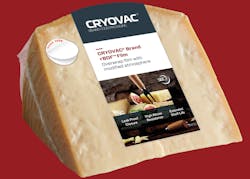Sealed Air taking steps toward more sustainable packaging
Sealed Air Corp., best known as the maker of Bubble Wrap, is expanding its strategies for producing sustainable packaging products, said Chad Stephens, the company’s VP of global innovation and development in equipment and applications. The company has long been involved in finding sustainable packaging solutions, he said.
Sealed Air produces a variety of protective and food packaging products and automated packaging systems. Sealed Air buys resins and substrate, creating its own proprietary film on a variety of extrusion platforms.
Sealed Air’s customers are pushing for “environmentally friendly” packaging materials, Stephens said. That can involve a variety of sustainability efforts, ranging from reducing the weight and volume of materials going into packaging, to incorporation of more post-industrial and post-consumer content, to greater use of renewable materials. The push for more-sustainable packaging has been going on for years and will continue growing, he said.
“It’s increased a lot over the years,” Stephens said. “We’ve been doing it for some time, and the industry continues to push that for reasons of circularity. When you get outside the U.S., you start getting into certain tax implications.”
Sealed Air has adopted a 2025 sustainability and materials pledge. It says that by 2025, 100 percent of the packaging materials it produces will be recyclable or reusable. In addition, the company aims to incorporate an average of 50 percent recycled or renewable content into its packaging. The company also plans to collaborate on advanced recycling technology and infrastructure, according to the Sealed Air website’s sustainability page.
The use of renewable content in packaging is expected to include bioplastics.
“Our goal is to positively impact the planet,” Stephens said. “Before some of these things were ever asked, we were on this journey. As a company, this is something that’s critical and near and dear to us. Even if not asked, we would be taking this initiative. But to answer [your] question, certainly the pull has grown and continues to grow from our customer base … It really does take everybody banding together to create a different industry for plastics.”
Sealed Air is working with resin suppliers on adopting more mono-material packaging that can be recycled. For example, resin companies are working to determine what types of barrier properties they can get from plastics in a single polymer category, whether it is PE or PP or PET.
“I think you see the industry moving toward that single-polymer type that fits into the recycle stream a little better,” Stephens said. “That is pushing us to do things with mono-polymers that we didn’t necessarily think we would be able to do probably 20 to 25 years ago.”
In the past, to create packaging with good sealing properties, a company typically would combine different types of polymers. Now, there is an emphasis on achieving the same properties while using only one polymer type.
Sealed Air, its suppliers, community groups, and its customers are collaborating and partnering on circularity strategies including collection and recycling programs for film.
“We worked with a particular retailer outside of the U.S., and they had a film collection program,” Stephens said. “In that take-back program, we had the material reprocessed, and then we made it into that final film factor that is then used in products that go to that retailer. Models are out there that exist. Where you’re at as an industry is, how do you scale that model? But certainly, some models do exist.”
Bruce Geiselman, senior staff reporter
Contact:
Sealed Air Corp., Charlotte, N.C., 980-430-7000, www.sealedair.com
About the Author
Bruce Geiselman
Senior Staff Reporter Bruce Geiselman covers extrusion, blow molding, additive manufacturing, automation and end markets including automotive and packaging. He also writes features, including In Other Words and Problem Solved, for Plastics Machinery & Manufacturing, Plastics Recycling and The Journal of Blow Molding. He has extensive experience in daily and magazine journalism.
